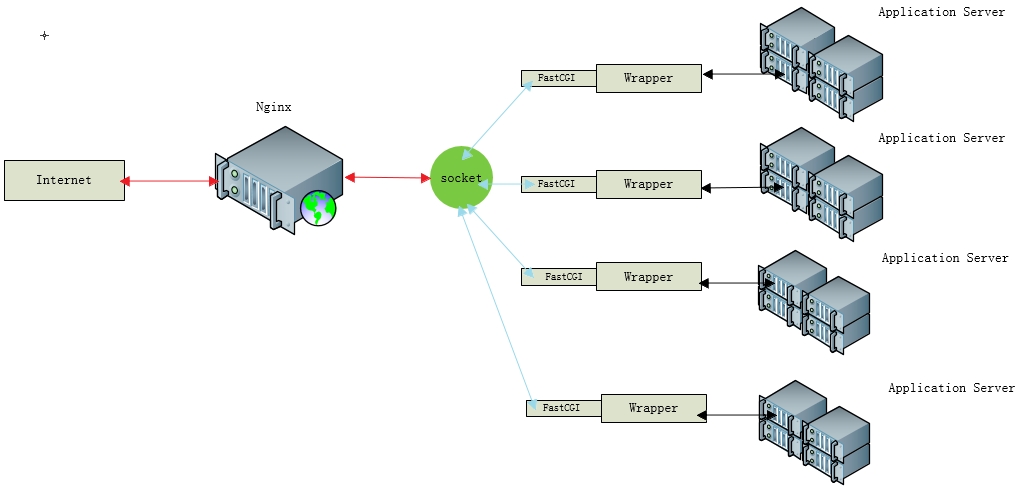初识linux之LEMP
什么是FastCGI?
PHP的FastCGI使你的所有php应用软件通过mod_fastci运行,而不是mod_phpsusexec。FastCGI应用速度很快 是因为他们持久稳定。不必对每一个请求都启动和初始化。这使得应用程序的开发成为可能,否则在CGI范例是不切实际的(例如一个大型的脚本,或者一个需要 连接单个或多个数据库的应用)。
1. FastCGI 像是一个常驻 (long-live) 型的 CGI,它可以一直执行着,只要激活后,不会每次都要花费时间去 fork 一次 (这是 CGI 最为人诟病的 fork-and-execute 模式)。
2. FastCGI 可在任何平台上使用,Netscape Enterprise 及 IIS 都有 FastCGI 的模块可供使用,阿帕契 (Apache,以及利用 Apache 衍生出做的服务器) 上也有 mod_fastcgi
3. FastCGI 支持 C/C++、Java、PHP、Python、Ruby、Perl,Tcl 等程序语言。
4. FastCGI 的应用程序亦兼容于 CGI。即 FastCGI 的应用程序也可以当成 CGI 来执行。
5. 现有的 CGI 程序要改写成 FastCGI 非常简单,最少可能只需要多加入三行程序代码。
6. FastCGI 的侦错方式与 CGI 大同小异,只要带入程序所需的环境变量及参数,即可在命令列模式执行或侦错。
7. FastCGI 应用程序的写作方式与 CGI 类似,除了几项原则要特别注意外,FastCGI 的写作方式跟 CGI 几乎一样,与学习 Web Server API 比较起来, FastCGI 简单多了。
8. FastCGI 支授分布式运算 (distributed computing),即 FastCGI 程序可以在网站服务器以外的主机上执行并且接受来自其它网站服务器来的请求。
好处
1. PHP脚本运行速度更快(3到30倍)。PHP解释程序被载入内存而不用每次需要时从存储器读取,极大的提升了依靠脚本运行的站点的性能。
2. 需要使用更少的系统资源。由于服务器不用每次需要时都载入PHP解释程序,你可以将站点的传输速度提升很高而不必增加cpu负担。因为dll文件不再每次都载入了,那么数据库的持久连接也将可以起到它设计初的效果。
3. 不需要对现有的代码作任何改变。
潜在问题
1. 对所有的子目录(/home/USERNAME/public_html/php.ini)你只有一个可用的php.ini文件。这是优化网站代码所必需的。如果你需要多个php.ini文件以适应不同的脚本需要,你可以在任何子目录禁用PHP的快速CGI,而其余的地方则继续有效。
2. 你对PHP环境做的任何升级(如php.ini文件的改变)都有几分钟的延迟。这是因为为了更快的速度 你的php.ini文件已经被载入内存,而不是每次需要时再从存储器重新读取。
Nginx+FastCGI运行原理
Nginx不支持对外部程序的直接调用或者解析,所有的外部程序(包括PHP)必须通过FastCGI接口来调用。FastCGI接口在Linux下是socket(这个socket可以是文件socket,也可以是ip socket)。为了调用CGI程序,还需要一个FastCGI的wrapper(wrapper可以理解为用于启动另一个程序的程序),这个wrapper绑定在某个固定socket上,如端口或者文件socket。当Nginx将CGI请求发送给这个socket的时候,通过FastCGI接口,wrapper接收到请求,然后派生出一个新的线程,这个线程调用解释器或者外部程序处理脚本并读取返回数据;接着,wrapper再将返回的数据通过FastCGI接口,沿着固定的socket传递给Nginx;最后,Nginx将返回的数据发送给客户端。这就是Nginx+FastCGI的整个运作过程,如图1-3所示。
传统上基于进程或线程模型架构的web服务通过每进程或每线程处理并发连接请求,这势必会在网络和I/O操作时产生阻塞,其另一个必然结果则是对内存或CPU的利用率低下。生成一个新的进程/线程需要事先备好其运行时环境,这包括为其分配堆内存和栈内存,以及为其创建新的执行上下文等。这些操作都需要占用CPU,而且过多的进程/线程还会带来线程抖动或频繁的上下文切换,系统性能也会由此进一步下降。
在设计的最初阶段,nginx的主要着眼点就是其高性能以及对物理计算资源的高密度利用,因此其采用了不同的架构模型。受启发于多种操作系统设计中基于“事件”的高级处理机制,nginx采用了模块化、事件驱动、异步、单线程及非阻塞的架构,并大量采用了多路复用及事件通知机制。在nginx中,连接请求由为数不多的几个仅包含一个线程的进程worker以高效的回环(run-loop)机制进行处理,而每个worker可以并行处理数千个的并发连接及请求。
如果负载以CPU密集型应用为主,如SSL或压缩应用,则worker数应与CPU数相同;如果负载以IO密集型为主,如响应大量内容给客户端,则worker数应该为CPU个数的1.5或2倍。
Nginx会按需同时运行多个进程:一个主进程(master)和几个工作进程(worker),配置了缓存时还会有缓存加载器进程(cache loader)和缓存管理器进程(cache manager)等。所有进程均是仅含有一个线程,并主要通过“共享内存”的机制实现进程间通信。主进程以root用户身份运行,而worker、cache loader和cache manager均应以非特权用户身份运行。
主进程主要完成如下工作:
1. 读取并验正配置信息;
2. 创建、绑定及关闭套接字;
3. 启动、终止及维护worker进程的个数;
4. 无须中止服务而重新配置工作特性;
5. 控制非中断式程序升级,启用新的二进制程序并在需要时回滚至老版本;
6. 重新打开日志文件,实现日志滚动;
7. 编译嵌入式perl脚本;
worker进程主要完成的任务包括:
1. 接收、传入并处理来自客户端的连接;
2. 提供反向代理及过滤功能;
3. nginx任何能完成的其它任务;
cache loader进程主要完成的任务包括:
1. 检查缓存存储中的缓存对象;
2. 使用缓存元数据建立内存数据库;
cache manager进程的主要任务:
1. 缓存的失效及过期检验;
Nginx的配置有着几个不同的上下文:main、http、server、upstream和location(还有实现邮件服务反向代理的mail)。配置语法的格式和定义方式遵循所谓的C风格,因此支持嵌套,还有着逻辑清晰并易于创建、阅读和维护等优势。
Nginx的代码是由一个核心和一系列的模块组成, 核心主要用于提供Web Server的基本功能,以及Web和Mail反向代理的功能;还用于启用网络协议,创建必要的运行时环境以及确保不同的模块之间平滑地进行交互。不过,大多跟协议相关的功能和某应用特有的功能都是由nginx的模块实现的。这些功能模块大致可以分为事件模块、阶段性处理器、输出过滤器、变量处理器、协议、upstream和负载均衡几个类别,这些共同组成了nginx的http功能。事件模块主要用于提供OS独立的(不同操作系统的事件机制有所不同)事件通知机制如kqueue或epoll等。协议模块则负责实现nginx通过http、tls/ssl、smtp、pop3以及imap与对应的客户端建立会话。
在nginx内部,进程间的通信是通过模块的pipeline或chain实现的;换句话说,每一个功能或操作都由一个模块来实现。例如,压缩、通过FastCGI或uwsgi协议与upstream服务器通信,以及与memcached建立会话等。
一、编译安装Nginx1.4.2
1、解决依赖关系
编译安装nginx需要事先需要安装开发包组"Development Tools"和 "Development Libraries"。同时,还需要专门安装pcre-devel包:
# yum -y install pcre-devel
2、安装
首先添加用户nginx,实现以之运行nginx服务进程
# groupadd -r nginx # useradd -r -g nginx nginx
接着开始编译和安装:
# ./configure --prefix=/usr/local/nginx --sbin-path=/usr/local/nginx/sbin/nginx --conf-path=/etc/nginx/nginx.conf --error-log-path=/var/log/nginx/error.log --http-log-path=/var/log/nginx/access.log --pid-path=/var/run/nginx/nginx.pid --lock-path=/var/lock/nginx.lock --user=nginx --group=nginx --with-http_ssl_module --with-http_flv_module --with-http_stub_status_module --with-http_gzip_static_module --http-client-body-temp-path=/var/tmp/nginx/client/ --http-proxy-temp-path=/var/tmp/nginx/proxy/ --http-fastcgi-temp-path=/var/tmp/nginx/fcgi/ --http-uwsgi-temp-path=/var/tmp/nginx/uwsgi --http-scgi-temp-path=/var/tmp/nginx/scgi --with-pcre # make && make install
关于配置选项的简单说明:
说明:如果想使用nginx的perl模块,可以通过为configure脚本添加--with-http_perl_module选项来实现,但目前此模块仍处于实验性使用阶段,可能会在运行中出现意外,因此,其实现方式这里不再介绍。如果想使用基于nginx的cgi功能,也可以基于FCGI来实现,具体实现方法请参照网上的文档。
--prefix=<path> - The path relative to which all other Nginx paths will resolve. If not specified, defaults to /usr/local/nginx.
--sbin-path=<path> - The path to the nginx executable. Only used for installation. If not specified defaults to <prefix>/sbin/nginx.
--conf-path=<path> - The default location of nginx.conf if no -c parameter is provided. If not provided, defaults to <prefix>/conf/nginx.conf.
--pid-path=<path> - The path to nginx.pid, if not set via the "pid" directive in nginx.conf. If not provided, defaults to <prefix>/logs/nginx.pid.
--error-log-path=<path> - The location of the error log if not set via the "error_log" in nginx.conf. If not set, defaults to <prefix>/logs/error.log.
--http-log-path=<path> - The location of the access log if not set via the "access_log" directive in nginx.conf. If not set, defaults to <prefix>/logs/access.log.
--user=<user> - The default user that nginx will run as if not set in nginx.conf via the "user" directive. If not set, defaults to "nobody".
--group=<group> - The default group that nginx will run under if not set via the "user" directive in nginx.conf. If not set defaults to "nobody".
--with-http_ssl_module - Enable ngx_http_ssl_module. Enables SSL support and the ability to handle HTTPS requests. Requires OpenSSL. On Debian, this is libssl-dev.
--with-http_flv_module - Enable ngx_http_flv_module
--http-client-body-temp-path=PATH - Set path to the http client request body temporary files. If not set, defaults to <prefix>/client_body_temp
--http-proxy-temp-path=PATH - Set path to the http proxy temporary files. If not set, defaults to <prefix>/proxy_temp
--http-fastcgi-temp-path=PATH - Set path to the http fastcgi temporary files. If not set, defaults to <prefix>/fastcgi_temp
--lock-path=<path> - The path to the nginx.lock file. If not provided, defaults to <prefix>/logs/nginx.lock.
3、为nginx提供SysV init脚本: /etc/rc.d/init.d/nginx,内容如下:
#!/bin/sh
#
# nginx - this script starts and stops the nginx daemon
#
# chkconfig: - 85 15
# description: Nginx is an HTTP(S) server, HTTP(S) reverse # proxy and IMAP/POP3 proxy server
# processname: nginx
# config: /etc/nginx/nginx.conf
# config: /etc/sysconfig/nginx
# pidfile: /var/run/nginx.pid
# Source function library.
. /etc/rc.d/init.d/functions
# Source networking configuration.
. /etc/sysconfig/network
# Check that networking is up.
[ "$NETWORKING" = "no" ] && exit 0
nginx="/usr/sbin/nginx"
prog=$(basename $nginx)
NGINX_CONF_FILE="/etc/nginx/nginx.conf"
[ -f /etc/sysconfig/nginx ] && . /etc/sysconfig/nginx
lockfile=/var/lock/subsys/nginx
make_dirs() {
# make required directories
user=`nginx -V 2>&1 | grep "configure arguments:" | sed ‘s/[^*]*--user=\([^ ]*\).*/\1/g‘ -`
options=`$nginx -V 2>&1 | grep ‘configure arguments:‘`
for opt in $options; do
if [ `echo $opt | grep ‘.*-temp-path‘` ]; then
value=`echo $opt | cut -d "=" -f 2`
if [ ! -d "$value" ]; then
# echo "creating" $value
mkdir -p $value && chown -R $user $value
fi
fi
done
}
start() {
[ -x $nginx ] || exit 5
[ -f $NGINX_CONF_FILE ] || exit 6
make_dirs
echo -n $"Starting $prog: "
daemon $nginx -c $NGINX_CONF_FILE
retval=$?
echo
[ $retval -eq 0 ] && touch $lockfile
return $retval
}
stop() {
echo -n $"Stopping $prog: "
killproc $prog -QUIT
retval=$?
echo
[ $retval -eq 0 ] && rm -f $lockfile
return $retval
}
restart() {
configtest || return $?
stop
sleep 1
start
}
reload() {
configtest || return $?
echo -n $"Reloading $prog: "
killproc $nginx -HUP
RETVAL=$?
echo
}
force_reload() {
restart
}
configtest() {
$nginx -t -c $NGINX_CONF_FILE
}
rh_status() {
status $prog
}
rh_status_q() {
rh_status >/dev/null 2>&1
}
case "$1" in
start)
rh_status_q && exit 0
$1
;;
stop)
rh_status_q || exit 0
$1
;;
restart|configtest)
$1
;;
reload)
rh_status_q || exit 7
$1
;;
force-reload)
force_reload
;;
status)
rh_status
;;
condrestart|try-restart)
rh_status_q || exit 0
;;
*)
echo $"Usage: $0 {start|stop|status|restart|condrestart|try-restart|reload|force-reload|configtest}"
exit 2
esac而后为此脚本赋予执行权限:
# chmod +x /etc/rc.d/init.d/nginx
添加至服务管理列表,并让其开机自动启动:
# chkconfig --add nginx # chkconfig nginx on
而后就可以启动服务并测试了:
# service nginx start
二、安装mysql-5-5-32
1、准备数据存放的文件系统
新建一个逻辑卷,并将其挂载至特定目录即可。这里不再给出过程。
这里假设其逻辑卷的挂载目录为/mydata,而后需要创建/mydata/data目录做为mysql数据的存放目录。
2、新建用户以安全方式运行进程:
# groupadd -r mysql # useradd -g mysql -r -s /sbin/nologin -M -d /mydata/data mysql # chown -R mysql:mysql /mydata/data
3、安装并初始化mysql-5.5.28
# tar xf mysql-5.5.28-linux2.6-i686.tar.gz -C /usr/local # cd /usr/local/ # ln -sv mysql-5.5.24-linux2.6-i686 mysql # cd mysql # chown -R mysql:mysql . # scripts/mysql_install_db --user=mysql --datadir=/mydata/data # chown -R root .
4、为mysql提供主配置文件:
# cd /usr/local/mysql # cp support-files/my-large.cnf /etc/my.cnf
并修改此文件中thread_concurrency的值为你的CPU个数乘以2,比如这里使用如下行:
thread_concurrency = 2
另外还需要添加如下行指定mysql数据文件的存放位置:
datadir = /mydata/data
5、为mysql提供sysv服务脚本:
# cd /usr/local/mysql # cp support-files/mysql.server /etc/rc.d/init.d/mysqld
添加至服务列表:
# chkconfig --add mysqld # chkconfig mysqld on
而后就可以启动服务测试使用了。
为了使用mysql的安装符合系统使用规范,并将其开发组件导出给系统使用,这里还需要进行如下步骤:
6、输出mysql的man手册至man命令的查找路径:
编辑/etc/man.config,添加如下行即可:
#MANPATH /usr/local/mysql/man
7、输出mysql的头文件至系统头文件路径/usr/include:
这可以通过简单的创建链接实现:
# ln -sv /usr/local/mysql/include /usr/include/mysql
8、输出mysql的库文件给系统库查找路径:
# echo ‘/usr/local/mysql/lib‘ > /etc/ld.so.conf.d/mysql.conf
而后让系统重新载入系统库:
# ldconfig
9、修改PATH环境变量,让系统可以直接使用mysql的相关命令。具体实现过程这里不再给出。
三、编译安装php-5.4.4
0、解决依赖关系:
# yum -y install bzip2-devel libmcrypt-devel
如果想让编译的php支持mcrypt、mhash扩展和libevent
另外,也可以根据需要安装libevent,系统一般会自带libevent,但版本有些低。因此可以编译安装之
说明:libevent是一个异步事件通知库文件,其API提供了在某文件描述上发生某事件时或其超时时执行回调函数的机制,它主要用来替换事件驱动的网络服务器上的event loop机制。目前来说, libevent支持/dev/poll、kqueue、select、poll、epoll及Solaris的event ports。
1、libevent
The libevent API provides a mechanism to execute a callback function when a specific event occurs on a file descriptor or after a timeout has been reached. Furthermore, libevent also support callbacks due to signals or regular timeouts.
libevent is meant to replace the event loop found in event driven network servers. An application just needs to call event_dispatch() and then add or remove events dynamically without having to change the event loop.
Currently, libevent supports /dev/poll, kqueue(2), event ports, select(2), poll(2) and epoll(4). The internal event mechanism is completely independent of the exposed event API, and a simple update of libevent can provide new functionality without having to redesign the applications. As a result, Libevent allows for portable application development and provides the most scalable event notification mechanism available on an operating system. Libevent can also be used for multi-threaded applications.
# tar zxvf libevent-1.4.14b-stable.tar.gz # cd libevent-1.4.14b-stable # ./configure # make && make install # make verify
2、libiconv
For historical reasons, international text is often encoded using a language or country dependent character encoding. With the advent of the internet and the frequent exchange of text across countries - even the viewing of a web page from a foreign country is a "text exchange" in this context -, conversions between these encodings have become important. They have also become a problem, because many characters which are present in one encoding are absent in many other encodings. To solve this mess, the Unicode encoding has been created. It is a super-encoding of all others and is therefore the default encoding for new text formats like XML.
Still, many computers still operate in locale with a traditional (limited) character encoding. Some programs, like mailers and web browsers, must be able to convert between a given text encoding and the user‘s encoding. Other programs internally store strings in Unicode, to facilitate internal processing, and need to convert between internal string representation (Unicode) and external string representation (a traditional encoding) when they are doing I/O. GNU libiconv is a conversion library for both kinds of applications.
# tar zxvf libiconv-1.13.1.tar.gz # cd libiconv-1.13.1 # ./configure # make && make install
3、libmcrypt
MCrypt is a replacement for the old crypt() package and crypt(1) command, with extensions. It allows developers to use a wide range of encryption functions, without making drastic changes to their code. It allows users to encrypt files or data streams without having to be cryptographers. Above all, it allows you to have some really neat code on your machine. :)
The companion to MCrypt is Libmcrypt, which contains the actual encryption functions themselves, and provides a standardized mechanism for accessing them.
# tar zxvf libmcrypt-2.5.8.tar.gz # cd libmcrypt-2.5.8 # ./configure # make && make install # ldconfig -v # cd libltdl # ./configure --with-gmetad --enable-gexec # make && make install
4、mhash
Mhash is a free (under GNU Lesser GPL) library which provides a uniform interface to a large number of hash algorithms. These algorithms can be used to compute checksums, message digests, and other signatures.
# tar jxvf mhash-0.9.9.9.tar.bz2 # cd mhash-0.9.9.9 # ./configure # make && make install # ln -sv /usr/local/lib/libmcrypt* /usr/lib/ # ln -sv /usr/local/lib/libmhash.* /usr/lib/
5、编译安装php5.4.26;
# tar xf php-5.4.4.tar.bz2 # cd php-5.4.4 # ./configure --prefix=/usr/local/php --with-openssl --enable-fpm --enable-sockets --enable-sysvshm --with-mysql=mysqlnd --with-pdo-mysql=mysqlnd --with-mysqli=mysqlnd --enable-mbstring --with-freetype-dir --with-jpeg-dir --with-png-dir --with-zlib-dir --with-libxml-dir=/usr --enable-xml --with-mhash --with-mcrypt --with-config-file-path=/etc --with-config-file-scan-dir=/etc/php.d --with-bz2 --with-curl # make # make test # make intall
说明:如果前面第1步解决依赖关系时安装mcrypt相关的两个rpm包,此./configure命令还可以带上--with-mcrypt选项以让php支持mycrpt扩展。--with-snmp选项则用于实现php的SNMP扩展,但此功能要求提前安装net-snmp相关软件包
为php提供配置文件:
# cp php.ini-production /etc/php.ini
为php-fpm提供Sysv init脚本,并将其添加至服务列表:
# cp sapi/fpm/init.d.php-fpm /etc/rc.d/init.d/php-fpm # chmod +x /etc/rc.d/init.d/php-fpm # chkconfig --add php-fpm # chkconfig php-fpm on
为php-fpm提供配置文件:
# cp /usr/local/php/etc/php-fpm.conf.default /usr/local/php/etc/php-fpm.conf # vim /usr/local/php/etc/php-fpm.conf
编辑php-fpm的配置文件:
# vim /usr/local/php/etc/php-fpm.conf
配置fpm的相关选项为你所需要的值,并启用pid文件(如下最后一行):注释:因为php-fpm默认只监听127.10.0.1:9000上;
pm.max_children = 150 pm.start_servers = 8 pm.min_spare_servers = 5 pm.max_spare_servers = 10 pid = /usr/local/php/var/run/php-fpm.pid listen = 0.0.0.0:9000
接下来就可以启动php-fpm了:
# service php-fpm start
使用如下命令来验正(如果此命令输出有中几个php-fpm进程就说明启动成功了):
# ps aux | grep php-fpm
默认情况下,fpm监听在127.0.0.1的9000端口,也可以使用如下命令验正其是否已经监听在相应的套接字。
# netstat -tnlp | grep php-fpm tcp 0 0 0.0.0.0:9000 0.0.0.0:* LISTEN 689/php-fpm
四、整合nginx和php5
1、编辑/etc/nginx/nginx.conf,启用如下选项:
location ~ \.php$ {
root html;
fastcgi_pass 127.0.0.1:9000;
fastcgi_index index.php;
fastcgi_param SCRIPT_FILENAME /scripts$fastcgi_script_name;
include fastcgi_params;
}2、编辑/etc/nginx/fastcgi_params,将其内容更改为如下内容:
fastcgi_param GATEWAY_INTERFACE CGI/1.1; fastcgi_param SERVER_SOFTWARE nginx; fastcgi_param QUERY_STRING $query_string; fastcgi_param REQUEST_METHOD $request_method; fastcgi_param CONTENT_TYPE $content_type; fastcgi_param CONTENT_LENGTH $content_length; fastcgi_param SCRIPT_FILENAME $document_root$fastcgi_script_name; fastcgi_param SCRIPT_NAME $fastcgi_script_name; fastcgi_param REQUEST_URI $request_uri; fastcgi_param DOCUMENT_URI $document_uri; fastcgi_param DOCUMENT_ROOT $document_root; fastcgi_param SERVER_PROTOCOL $server_protocol; fastcgi_param REMOTE_ADDR $remote_addr; fastcgi_param REMOTE_PORT $remote_port; fastcgi_param SERVER_ADDR $server_addr; fastcgi_param SERVER_PORT $server_port; fastcgi_param SERVER_NAME $server_name;
并在所支持的主页面格式中添加php格式的主页,类似如下:
location / {
root html;
index index.php index.html index.htm;
}而后重新载入nginx的配置文件:
# service nginx reload
3、在/usr/html新建index.php的测试页面,测试php是否能正常工作:
# cat > /usr/html/index.php << EOF <?php phpinfo(); ?>
接着就可以通过浏览器访问此测试页面了。
五、安装xcache,为php加速:
1、安装
# tar xf xcache-2.0.0.tar.gz # cd xcache-2.0.0 # /usr/local/php/bin/phpize # ./configure --enable-xcache --with-php-config=/usr/local/php/bin/php-config # make && make install
安装结束时,会出现类似如下行:
Installing shared extensions: /usr/local/php/lib/php/extensions/no-debug-zts-20100525/
2、编辑php.ini,整合php和xcache:
首先将xcache提供的样例配置导入php.ini
# mkdir /etc/php.d # cp xcache.ini /etc/php.d
说明:xcache.ini文件在xcache的源码目录中。
接下来编辑/etc/php.d/xcache.ini,找到zend_extension开头的行,修改为如下行:
zend_extension = /usr/local/php/lib/php/extensions/no-debug-zts-20100525/xcache.so
注意:如果php.ini文件中有多条zend_extension指令行,要确保此新增的行排在第一位。
3、重新启动php-fpm
# service php-fpm restart
六、补充说明
如果要在SSL中使用php,需要在php的location中添加此选项:
fastcgi_param HTTPS on;
本文出自 “grep命令基础应用” 博客,请务必保留此出处http://7943682.blog.51cto.com/7933682/1381744
郑重声明:本站内容如果来自互联网及其他传播媒体,其版权均属原媒体及文章作者所有。转载目的在于传递更多信息及用于网络分享,并不代表本站赞同其观点和对其真实性负责,也不构成任何其他建议。






































